#acer saccharinum
Text
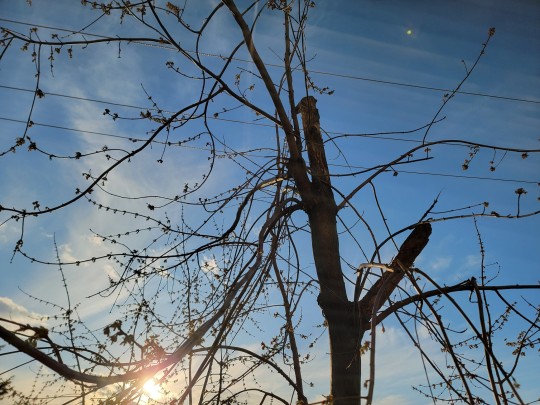
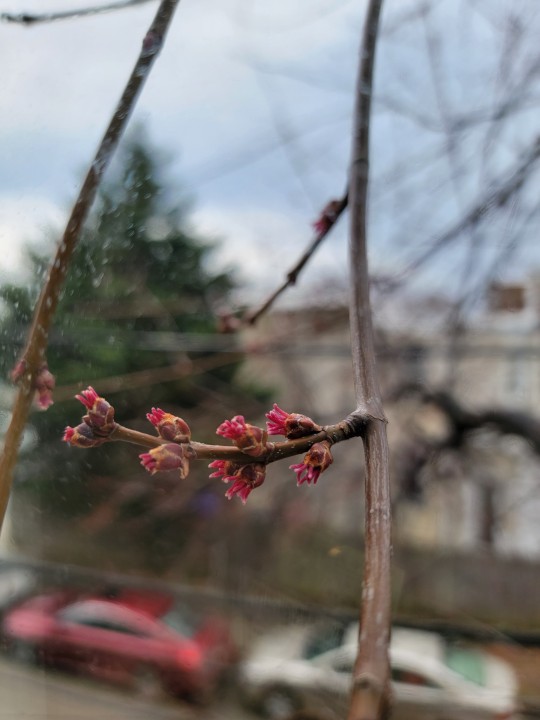
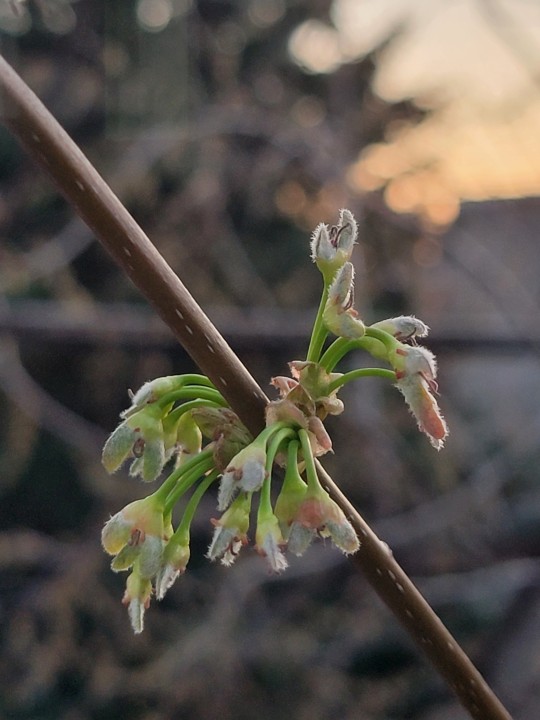

Acer saccharinum - Silver Maple
Today's plant profile is on a controversial favorite of mine, the silver maple.
This tree is reviled or loved depending on who you talk to, although it is naturally found in riparian and wetland zones the silver maple can thrive in dry, polluted, and urban environments; therefore it is extremely adaptable to a wide variety of soil conditions. Maples are usually thought of as a secondary growth forest species able to survive under shade, however silvers like a little more sunlight and are often found on forest edges.
You can identify a silver maple by its broken looking shaggy bark which is smooth silver brown when young. Most identifiable are the leaves which are symmetrical with 5-7 lobes and slightly toothed and fairly large (image 4-courtesy of inaturalist). In spring, red buds turn to young red flowers around march (image 2). Soon they turn into hairy green-silver developing fruit (image 3) which usually end up being a reddish-light green samara (the helicopter seedling) that are enjoyed by birds and squirrels. Usually the tree produces a lot, expect a lot of seedlings in sunny wet areas. All of those images are taken outside of my apartment window. I must note that occasionally silver maples retain seedlings during winter, this is another way to identify them (its not universal for some reason, haven't seen writting on this).
Given the harsh conditions of which it can survive its no surprise that the tree often grows into twisted, easily broken, messy forms. Branches often break off in storms and it's common for parts of trunks to die off and sprout again. In addition to that, urban dwellers hate the surface exploratory nature of its root system which kicks up sidewalk.

Personally I find this vigorous nature appealing as, if I may be quite blunt, this tree is indestructible. I've seen this tree survive 4 feet of rushing water (below) and an ash trunk fall ontop of it (above), this is no quitter. You may also notice in my images the silver maples are growing in a thicket of bamboo...they can be competitive against more aggressive invasives. This makes them great for restoration projects, given our higher frequency of heavy precipitation events due to accelerated global warming, they can survive instability.


This species is extremely common and native to the entirety of eastern North America above the Florida panhandle. It has been planted as a street tree all over the world, sometimes hybridized with other maples (typically acer rubrum).
Ethnobotanically, like many eastern wetland species, silver maple is seen as a medicinal plant by multiple indigenous tribes (given its range this includes numerous of groups). Some research discusses hot water infusions of bark as a treatment for common stomach ailments (sometimes as a tea as well). I only have experience with its sugary sap, nearly all maples have sweet sap which can be transformed into syrup, this isn't as good as sugar maple sap but it is possible. Additionally, silver maple is an excellent tree for pollarding, indigenous groups and settlers alike use the prolific branch growth for basket making.
In terms of propagating silver maples, I have never has anyone ask me to, seedlings will take off on any wet site. I believe you can also propagate branch cuttings from new growth taken during mid-summer months, I haven't personally tried this yet.
So that was the story of Silver Maple, look out for its unique leaves and keep in mind that even the ugliest trees can surprise us.
#acer saccharinum#silver maple#plant profiles#native plants of northeastern america#United states flora
8 notes
·
View notes
Text


Brittnee’s plant of the day 5/?
The Sugar Maple 😍🫶 (Acer saccharinum) is the tree that lights up the hills of New England in Autumn. You can identify this tree by its 5 lobed leaf and U shaped sinus. Remember the leaf is smaller than the Norway Maple! Producing delicious sap for maple syrup, it’s an essential tree for New England’s and Canada’s economy. The star for leaf peepers in Autumn, this tree is native to the Northeast United States (yay that’s where I live!) and Canada. Our Sugar Maples are threatened by climate change, where the warmer winters are effecting the trees’ health and the maple industry . More information about the maple decline can be found here x. These are finicky trees who don’t like to be alone and need friends, they can’t handle a lot of air pollution so planting in forests or parks is best! We love u sugar maples, we will protect you! 🍁
Photo credits and more information: x x
#horticulture#woody plants#trees#sugar maple#acer saccharinum#botany#native plants of America#climate change#maple syrup#plant of the day#plants#arboriculture#aborists#autumn#naturecore#gardening
5 notes
·
View notes
Text



Silver maples (Acer saccharinum) flowering on campus today. The pale greenish stamen filaments erupting from those brilliant red bud scales makes such a pretty contrast 🌺
1 note
·
View note
Text
instagram
#Instagram#rachel mentzer#fall#autumn#oak#maple#Quercus#autumn leaves#acer#beech#Fagus#acorn#silver maple#Acer saccharinum#pin oak#Quercus palustris#oregon white oak#Quercus garryana#pinecone
1 note
·
View note
Text
Oxbow Argentina -Planta Copetro- donó 500 árboles a la Municipalidad de Ensenada
#Sociedad #Industria | #OxbowArgentina #PlantaCopetro donó 500 árboles a la Municipalidad de #Ensenada
En el marco de colaboración con el Plan de Forestación que el municipio está desarrollando para potenciar los espacios verdes públicos y las veredas de la ciudad, la empresa donó 500 árboles de especies variadas, entre los cuales se encuentran: fresno rojo, pseudoacacia, pezuña de vaca, morera híbrida, acer negundo y acer saccharinum.En el contexto de este, se encuentra el Programa de Forestación…

View On WordPress
#acer negundo#acer saccharinum#árboles#Desarrollo Sustentable#Ensenada#Escuela Técnica N° 1#Espacios Verdes#fresno rojo#FUNDACORE#Hospital de Niños de La Plata#morera híbrida#Oxbow Argentina#Pezuña de Vaca#Plan de Forestación#Planta Copetro#pseudoacacia#residuos orgánicos#veredas
0 notes
Text
Native Plants I’ve Actually Seen Growing Wild in Southern Ontario
Acer saccharinum (silver maple) --along the sides of highways
Acer saccharum (sugar maple) --GTA ravines
Achillea millefolia (yarrow) --GTA ravines
Allium schoenoprasum (wild chives) --GTA ravines, Ridgetown
Allium tricoccum (ramps) --Niagara region escarpments
Amaranthus retroflexus (redroot amaranth) --fallow areas in the GTA
Ambrosia artemisiifolia (ragweed) --fallow areas in the GTA
Ambrosia trifida (giant ragweed) --parks in the GTA
Amelanchier spp. (saskatoon/serviceberry) --GTA ravines
Arisaema triphyllum (Jack-in-the-pulpit) --GTA ravines
Aronia melanocarpa (black chokeberry) --ravines and parks in the GTA
Asarum canadense (Canada ginger) --GTA ravines
Asclepias syriaca (common milkweed) --fallow areas, ravines, and parks throughout southern Ontario from Windsor to GTA
Asplenium trichomanes (maidenhair spleenwort) --Niagara region escarpments
Betula spp. (birch) --ravines and parks throughout southern Ontario from Windsor to GTA
Bidens spp. (beggar ticks) --GTA ravines
Caulophyllum thalictroides (blue cohosh) --GTA parks
Ceratophyllum demersum (hornwort) --GTA ravines (native in freshwater across the globe anyway)
Circaea lutetiana (enchanter’s nightshade) --fallow areas in the GTA
Commelina spp. (dayflower) --fallow areas in Windsor
Cornus alternifolia (Pagoda dogwood) --GTA wooded areas
Cornus sericea (red osier dogwood) --GTA ravines and in Windsor riverside parks
Crataegus spp. (hawthorn) --GTA ravines and parks
Echinocystis lobata (wild prickly cucumber) --GTA ravines
Elaeagnus commutata (silverberry) --GTA parks and fallow areas
Epilobium ciliatum (fringed willowherb) --fallow areas in the GTA
Equisetum spp. (horsetail/scouring rush) --GTA ravines and fallow areas
Erigeron spp. (fleabane) --GTA parks and fallow areas, Ridgetown
Erythronium americanum (trout lily) --GTA ravines and parks
Eutrochium maculatum (Joe-Pye weed) --GTA parks
Fragaria virginiana (wild strawberry) --fallow areas in the GTA
Geranium maculatum (wild geranium) --Windsor green spaces
Geranium robertianum (herb robert) --Windsor green spaces
Geum aleppicum (yellow avens) --GTA fallow areas
Geum canadense (white avens) --GTA fallow areas
Geum macrophyllum (large-leaved avens) --GTA fallow areas
Gymnocladus dioicus (Kentucky coffee tree) --GTA ravines
Helianthus spp. (sunflower) --GTA fallow areas and parks
Heracleum maximum (cow parsnip) --GTA ravines
Hordeum jubatum (foxtail barley) --GTA fallow areas
Humulus lupulus (hops) --GTA ravines
Hydrophyllum virginianum (Virginia waterleaf) --GTA ravines
Impatiens capensis (jewelweed) --GTA ravines and in Windsor riverside parks
Juglans nigra (black walnut) --GTA ravines
Lactuca canadensis (Canadian lettuce) --GTA fallow areas
Lilium michiganense (Michigan lily) --GTA ravines
Lupinus perennis (sundial lupine) --GTA parks
Maianthemum canadense (Canada mayflower) --GTA ravines
Maianthemum racemosum (starry false solomon’s seal) --GTA ravines and parks
Maianthemum stellatum (starry false solomon’s seal) --GTA ravines
Matteuccia struthiopteris (ostrich fern) --GTA ravines
Monarda fistulosa (wild bergamot) --GTA ravines and parks
Morus rubra (red mulberry) --fallow areas in Windsor, GTA parks
Myosotis laxa (smallflower forget-me-not) --GTA fallow areas
Oenothera biennis (evening primrose) --GTA fallow areas
Onoclea sensibilis (sensitive fern) --GTA ravines
Oxalis stricta (yellow wood sorrel) --fallow areas and ravines throughout southern Ontario from Windsor to GTA
Parietaria pensylvanica (Pennsylvania pellitory) --GTA fallow areas
Parthenocissus quinquefolia (Virginia creeper) --Windsor fallow areas and GTA ravines and parks
Persicaria lapathifolia (curlytop smartweed) --GTA fallow areas
Podophyllum peltatum (mayapple) --GTA ravines and parks
Portulaca oleracea (purslane) --fallow areas throughout southern Ontario from Windsor to GTA (native globally anyway)
Potentilla norvejica monspeliensis (ternate-leaved cinquefoil) --GTA fallow areas
Prunella vulgaris (selfheal) --fallow areas and ravines throughout southern Ontario from Windsor to GTA
Prunus virginiana (chokecherry) --Windsor fallow areas, GTA ravines and parks, Niagara region escarpments
Pteridium aquilinum latiusculum (western bracken fern) --GTA parks
Quercus spp. (oak) --wooded areas throughout southern Ontario from Windsor to GTA
Rhus typhina (staghorn sumac) --parks and fallow areas throughout southern Ontario from Windsor to Collingwood
Ribes spp. (currants) --GTA ravines and parks
Ribes spp. (gooseberries) --GTA ravines
Robinia pseudoacacia (black locust) --GTA ravines and parks
Rosa spp. (roses) --GTA ravines, parks, and fallow areas
Rubus occidentalis (black raspberry) --ravines, parks, and fallow areas in Hamilton and GTA
Rubus odoratus (purple-flowered raspberry) --GTA ravines and parks
Rubus strigosus (American red raspberry) --GTA parks
Rudbeckia hirta (black-eyed susan) --GTA parks
Salix spp. (willow) --GTA ravines
Sambucus canadensis (common elderberry) --Windsor riverside parks, GTA ravines
Sambucus racemosa (red elderberry) --GTA ravines and parks
Smilax spp. (greenbrier) --GTA parks
Solidago canadensis (Canada goldenrod) --parks and fallow areas throughout southern Ontario from Windsor to GTA
Sorbus spp. (mountain ash) --GTA ravines and parks
Streptopus spp. (twistedstalk) --GTA parks
Symphoricarpos spp. (snowberry) --GTA parks
Symphyotrichum ericoides (heath aster) --fallow areas throughout southern Ontario from Windsor to GTA
Symphyotrichum novae-angliae (New England aster) --fallow areas throughout southern Ontario from Windsor to GTA
Symplocarpus foetidus (skunk cabbage) --GTA parks
Tilia spp. (linden) --GTA ravines
Trillium grandiflorum (white trillium) --parks throughout southern Ontario from Windsor to GTA
Tsuga canadensis (eastern hemlock) --GTA parks
Typha latifolia (broad-leaved cattail) --marshes in Essex county and GTA
Urtica gracilis (slender nettle) --GTA ravines
Uvularia spp. (bellwort) --streams in Windsor green spaces
Verbena hastata (blue vervain) --GTA ravines
Viburnum lentago (nannyberry) --GTA parks and Ridgetown ravine
Viburnum trilobum (highbush cranberry) --Ridgetown
Viola sororia (wood violet) --fallow areas and wooded areas throughout southern Ontario from Windsor to GTA
Vitis riparia (riverbank grape) --GTA fallow areas, ravines, and parks
Waldsteinia fragarioides (barren strawberry) --GTA ravines and parks
Xanthium strumarium canadense (Canada cocklebur) --GTA parks and fallow areas
I’ve likely seen many others and just couldn’t identify them, but there are a lot I’ve never seen growing wild. What I’m hoping is that some of the native species I have in my garden will make their way to the nearby ravine. If I get around to it, though, I might just take a walk with some Asclepias incarnata (swamp milkweed) seeds in the fall. They certainly seem to successfully germinate in my garden whether I want them to or not (don’t have space for them to go crazy). Can’t see why they wouldn’t in a natural swamp area.
#text post#long text post#native plants of Ontario#native plants of North America#wild native plants
10 notes
·
View notes
Note
Spooky month is getting closer!!!
Devil's tooth mushroom! She's so mysterious and playful. She'll scare anyone for funsies and laughs. But other bots would believe she's cruel and malevolent.
"Oh, you should've seen the look on your face! It was hilarious!"
Autumn blaze maple bonsai! She's a highly trained witch! A traditional and whimsy witch. She keeps herself perfect, especially her leaves. Her spells also give off a hint of maple syrup
"Ah! I didn't see you there stranger, I was looking for my familiar... you don't happen to see them do you? A baby owl, about this high, very loud... no?"
Pumpkin cupcake! Anything about Halloween just makes this bot about to die in joy! Has the true spirit of Halloween in him.
"Every corner must have cobwebs and bats- oh maybe some fake ghosts here and there!"
Monster doughnut! She and devil's tooth are partners in pranking bots. On occasion, she would scare bots with her fake eyes on her body.
"Boo! Botbots!"
Black widow cocktail! She doesn't seem so thrilled about meeting bots on Halloween. Especially the ones that look so saturated, a striking contrast to the aesthetic of Halloween. She doesn't like anyone opposing the Halloween aesthetic.
"*sigh* first the babbling now some stupid party, that doesn't have Halloween aesthetic to it?! Unbelievable!!!"
Big brown bat! He simply can't wait to meet new bots before he goes to hibernation. He just needs to speed up before it's too late.
"Wow, who knew flying all the way here would take a lot out of you *panting*"
Barn owl! Good friends with BBB☝️. Seems patient and methodical with anyone he interacts with.
"I appreciate your kind gesture in handing me these 'Hors D'oeuvres'? But I must decline of course"
Red fox! If you invited him, big mistake! He'd swipe anything he finds interesting or delicious.
"Oooohhhh, that's a very nice sword you got there my friend... tell me more about it"
Badger! He's confident that finding food would be easy after meeting the indoor bots! He would still stick around even after the party ended.
"*chuckles* that cool, you got the cool vibe my dude"
Hawthorn bonsai! Another witch bonsai!!! But unlike Autumn blaze maple bonsai, she's more attuned with dark magic. But she's also cursed. But she tells everybody that she's still okay.
"Oh this mark? Oh yyyeeeeaaaahhhhhh, I'm cursed, but it's totally okay! I'm fine"
Eyeball macaron! They really like staring into anyone's eyes with admiration. Unfortunately, everyone thought that they were threatening because their eyes were piercing like daggers!
"you seem very scared... what's the matter?"
Marxophone! Likes to set the mood for the new bots in their party with a little spooky music! He likes to do this with passion and enthusiasm, not really in bad intentions.
"oooohhhh~ are you scared yet?"
Waterphone! Marxophone's partner. If Marxophone's efforts didn't work, them Waterphone just take his place.
"fine, I'll help you out. I bet they wouldn't be prepared for me"
A trick or treat bucket! He'll grab any sweets and throw them in his head, even if those sweets are botbots. Surprisingly, he doesn't eat them.
"Sweets! Sweets! Sweets!!!"
Pectati(Hydnellum Peckii, the red is guttation droplets)
Saccharum(Autumn Blaze Maple are a cross between red maples[acer rubrum] and silver maples[acer saccharinum])
Hallofrost
Longanberry Duh'nut(surprise, those fake eyes are edible!)
Blanctan(black widow cocktails specify using blanco tequila, and latrodectus mactans is the southern black widow, which can be found in Mexico, where tequila is made)
Serocus(while there is a species called the big brown bat[eptesicus fuscus], that phrase can also be used to describe the serotine bat[eptesicus serotinus])
Tytodil(barn owls have two extant genera: tyto and phodilus)
Vulfer(vulpes and pilfer)
Melaxu(is it an american bagder[taxidea taxus] or an european bagder[meles meles]? who can say?)
Hecathorn(hecate, greek goddess of witchcraft)
Ocularon(globe oculaire, french for eyeball)
Zithemo(the marxophone is a type of zither that makes a temolo sound)
Resocea(the resonator is the main part of the waterphone, also known as the ocean harp)
Sweetula(Situla, a type of bucket)
3 notes
·
View notes
Text
Is Silver Maple a Hardwood? Discover Its Durable Strength and Versatility!

No, Silver Maple is not a hardwood. It is a species of softwood tree.
Silver Maple, scientifically known as Acer saccharinum, is not classified as a hardwood. Rather, it falls under the category of softwood trees due to its physical characteristics. This deciduous tree is native to eastern North America and is known for the distinctive silver underside of its leaves, hence the name.
While softwoods like Silver Maple are commonly used for various applications, including furniture, construction, and flooring, they differ from hardwoods in terms of density and durability. We will explore the unique features and uses of Silver Maple, shedding light on the differences between hardwoods and softwoods. Whether you are a wood enthusiast or simply curious about Silver Maple, read on to discover more about this remarkable softwood species.
Understanding Silver Maple As A Hardwood
Silver Maple is classified as a hardwood due to its dense and sturdy nature. It is commonly used in furniture making and flooring due to its durability and attractive grain patterns. This hardwood is a popular choice for various woodworking projects, thanks to its strength and versatility.
Identifying Silver Maple
When it comes to understanding silver maple as a hardwood, it’s essential to start by identifying this versatile and widely-used wood species. Silver maple, scientifically known as Acer saccharinum, is a deciduous tree that is native to North America. It gets its name from the silvery undersides of its leaves, which give the tree a shimmering appearance.
Identifying silver maple can be fairly straightforward. The tree typically grows to a height of 60 to 80 feet, with a spread of 40 to 60 feet. Its broad crown and thick branches create a distinctive and picturesque silhouette. The bark of the silver maple is rough and grayish-brown, with shallow furrows and ridges.
Properties Of Silver Maple
Now that we have identified silver maple let's delve into its properties as a hardwood. Silver maple is valued for its durability and strength, making it an excellent choice for a variety of applications. Here are some key properties of silver maple:
- Density: Silver maple has a medium density, falling between 450-500 kg/m³. This density allows it to maintain both stability and versatility, providing a balance between strength and workability.
- Color and Grain: The heartwood of silver maple typically ranges from light to medium brown, with occasional reddish-brown streaks. The sapwood, on the other hand, is usually pale yellow. The grain pattern of silver maple is often straight, though it can occasionally have a wavy or curly appearance.
- Hardness: Silver maple is considered a relatively soft hardwood, with a Janka hardness rating of around 700 lbf. While it may not be as hard as some other hardwood species, such as oak or hickory, it still offers sufficient strength for many applications.
- Workability: One of the standout features of silver maple is its workability. It has good machining properties, allowing it to be easily shaped, cut, and worked with standard woodworking tools. This makes it a versatile choice for a wide range of projects.
- Uses: Silver maple is commonly used in the production of furniture, cabinets, flooring, and moldings. Its attractive appearance and ability to take stains and finishes well make it a popular choice for both interior and exterior applications.
Understanding the identification and properties of silver maple as a hardwood can give you valuable insights into its use and potential for your woodworking projects. Its durability, unique grain patterns, and workability make it a great option for various applications, both functional and decorative.

Applications Of Silver Maple
Silver Maple is a popular hardwood that finds numerous applications in various industries. Its durability, attractive appearance, and ease of working make it a preferred choice for different projects. two significant applications of Silver Maple are in furniture making and flooring and cabinetry.
Furniture Making
When it comes to furniture making, Silver Maple proves to be an excellent choice for both indoor and outdoor pieces. Its light color, smooth texture, and straight grain create a beautiful and elegant look that blends well with any style of decor.
With its remarkable workability, Silver Maple can be easily shaped and carved into intricate designs, making it a favorite among furniture craftsmen.
Not only is Silver Maple visually appealing, but it is also renowned for its strength and durability, ensuring that furniture made from this wood will stand the test of time.
From tables and chairs to cabinets and headboards, Silver Maple furniture adds a touch of sophistication and charm to any living space.
Flooring And Cabinetry
When it comes to flooring and cabinetry, Silver Maple is a versatile choice that offers both practicality and aesthetics. Its natural resistance to wear and tear, along with its ability to withstand heavy foot traffic, make it a perfect option for flooring in high-traffic areas.
With its light color and subtle grain pattern, Silver Maple flooring brightens up any room, creating an inviting and spacious atmosphere. Whether in a residential or commercial setting, this hardwood flooring provides an excellent foundation for interior design.
Not only is Silver Maple suitable for flooring, but it also excels in cabinetry. Its fine texture and uniform appearance make it an ideal choice for creating custom cabinets in kitchens, bathrooms, and other areas of the home.
With its excellent workability, Silver Maple can be easily cut, shaped, and finished to achieve the desired look. From sleek modern cabinets to traditional farmhouse-style cabinetry, Silver Maple can be tailored to suit any design preference.
In addition to its natural beauty, Silver Maple is an environmentally friendly option for flooring and cabinetry projects. By choosing this sustainable hardwood, homeowners can contribute to a greener and more eco-conscious lifestyle.
Challenges And Considerations
Silver Maple is a popular hardwood choice for various projects, offering a balance of durability and aesthetic appeal. However, there are some challenges and considerations to keep in mind when working with this wood species.
Vulnerability To Decay
Silver Maple is known for its susceptibility to decay and rotting when exposed to moisture. Extra precautions need to be taken to protect the wood from these elements, such as proper sealing and regular maintenance.
Staining And Finishing
When it comes to staining and finishing, Silver Maple can present some challenges. Its open grain can lead to uneven staining, requiring careful preparation and application techniques to achieve a smooth and consistent finish.
Sustainability And Environmental Impact
When considering using silver maple as a hardwood, it is important to understand its sustainability and environmental impact. This section will explore the growth and harvesting process of silver maple, as well as compare its sustainability to other hardwood options.
Growth And Harvesting
The growth of silver maple begins with the planting of seeds or the use of saplings in controlled environments. These trees can grow relatively quickly, reaching maturity within 20-30 years. Once matured, they are ready for harvesting.
During the harvesting process, it is crucial to implement sustainable practices. By selectively cutting trees and replanting, we can ensure the continuation of silver maple as a renewable resource. This sustainable method allows the forest to maintain its biodiversity while still utilizing the timber from silver maple trees.
Comparative Sustainability
Compared to other commonly used hardwoods, such as oak or walnut, silver maple is considered to be more sustainable. Its fast growth rate means that it can be replenished relatively quickly compared to slower-growing hardwood varieties. This rapid regeneration makes it an attractive option for those concerned about the environmental impact of their wood choices.
To better understand the sustainability of silver maple, let's compare it to oak, a popular hardwood choice. While oak is known for its durability and strength, it takes significantly longer to mature, sometimes reaching ages of 100 years or more. This slow growth rate means that harvesting oak can have a more significant impact on the environment.
In addition to its fast growth, silver maple has other sustainability benefits. For example, its extensive root system helps prevent soil erosion and improve water quality. These environmental advantages make it an even more appealing choice for those looking for eco-friendly hardwood options.
In conclusion, silver maple proves to be a sustainable hardwood choice due to its fast growth, selective harvesting practices, and positive environmental impact. Its ability to regenerate relatively quickly, coupled with its eco-friendly characteristics, make it an excellent option for those who value sustainability.
Conclusion And Future Prospects
Silver Maple, a hardwood commonly found in North America, offers various future prospects in the field of construction and woodworking due to its durability and appealing appearance. Its potential for utilization in furniture and flooring makes it a promising choice for both homeowners and industry professionals.
Technological Advancements
Technological advancements play a vital role in shaping the future prospects of the silver maple hardwood industry. With the advent of new and innovative technologies, the processing and manufacturing of silver maple have become more efficient and cost-effective. These advancements have enabled the production of high-quality silver maple products with improved durability and aesthetics.
One noteworthy technological advancement in the silver maple industry is the use of computer-aided design (CAD) software. This software allows manufacturers to create precise and intricate designs, resulting in beautifully crafted furniture and flooring options. Additionally, CAD software helps optimize material usage, reducing waste and minimizing environmental impact.
Market Demand
Market demand for silver maple hardwood has been steadily increasing in recent years, and this trend is expected to continue in the future. The durability, versatility, and unique aesthetic appeal of silver maple make it a highly sought-after material for various applications.
In the furniture industry, silver maple is valued for its distinctive grain patterns and warm, golden color. It is often used to create elegant and timeless pieces that add charm to any living space. Similarly, in the flooring industry, silver maple is a popular choice due to its durability and resistance to wear and tear.
The market demand for silver maple is not limited to the domestic market. It has gained prominence in the international market as well, with buyers appreciating its natural beauty and eco-friendly characteristics. This global demand creates opportunities for the expansion of silver maple production and export.
Overall, the combination of technological advancements and increasing market demand bodes well for the future prospects of the silver maple hardwood industry. As more manufacturers embrace advanced technologies and consumers continue to appreciate the beauty and durability of silver maple, this hardwood is poised for a bright and prosperous future.
Silver Maple Hardwood: Conclusion and Future Prospects
Key Points
Technological advancements enhance efficiency and quality in silver maple processing.
The use of CAD software allows for precise designs and optimized material usage.
Market demand for silver maple is increasing both domestically and internationally.
Silver maple is valued in the furniture and flooring industries for its unique aesthetic appeal and durability.
The combination of technological advancements and market demand ensures a promising future for silver maple hardwood.

Credit: www.shutterstock.com
Frequently Asked Questions On Is Silver Maple A Hardwood
Is Silver Maple Wood Good For Anything?
Yes, silver maple wood is versatile and has various uses. It is commonly used for furniture, cabinets, flooring, and even musical instruments due to its strength and attractive grain patterns.
Is A Silver Maple A Hard Or Soft Maple Tree?
Yes, a silver maple is a soft maple tree with relatively softer wood compared to a hard maple.
Is Silver Maple Good For Cutting Boards?
Yes, silver maple is a good option for cutting boards. It is known for its durability and moisture resistance, making it suitable for kitchen use. Its tight grain pattern also helps prevent knife marks.
What Is The Silver Maple Tree Used For?
The silver maple tree is used for its hardwood in furniture and flooring. It is also a popular choice for landscaping due to its fast growth and attractive silver leaves. Additionally, its sap can be collected and used to make maple syrup.
Conclusion
Silver Maple is considered a hardwood due to its density and durability. Its versatility makes it a popular choice for various woodworking projects. When evaluating the characteristics of Silver Maple, it's clear that it exhibits many of the traits associated with hardwoods, making it a reliable and attractive option for your woodworking needs.
Read the full article
0 notes
Text
The Magic of Maple Syrup: From Tree to Table
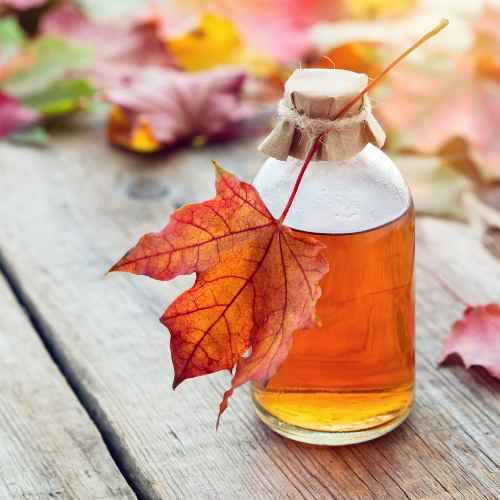
Maple syrup, one of nature's most popular sweeteners, is far more than just a breakfast condiment and could be seen as a testament to nature's bounty and human ingenuity. The deep flavour and smooth texture of this syrup have made it a staple in many households. In this article we take a look at the journey of maple syrup from tree to table, exploring its history, production process, and various uses. We also investigate the nutritional aspects and consider its place in the sugar spectrum from a health perspective.
What is Maple Syrup
Maple syrup is a sweet, natural syrup that's derived from the sap of certain species of maple trees, primarily the sugar maple. It has a rich amber colour and a distinctive sweet flavour. A traditional product of North America, and especially Canada, this natural sweetener is used in a variety of dishes and recipes, from pancakes and waffles to glazes and sauces. It continues to gain popularity as a healthier alternative to sugar and a store cupboard staple for healthy baking.
The Majestic Maple Tree
Maple syrup is made from the sap of maple trees which belong to the genus Acer. These majestic trees are primarily found in northeastern North America and Canada, with some species also found in Europe and Asia.
When it comes to syrup production, not all maple trees are created equal. The Sugar Maple (Acer saccharum) is the most commonly used due to its high sugar content. This species also referred to as the Rock Maple or Hard Maple, is native to the hardwood forests of North America and is easily identifiable by its five-lobed leaves and striking autumn coloration. The Black Maple (Acer nigrum), a close relative of the Sugar Maple, is another tree used for syrup production. Although it has a lower sugar content, it's favoured in some regions for its sap yield. The Red Maple (Acer rubrum) and the Silver Maple (Acer saccharinum) can also be tapped for sap, but they have lower sugar concentrations and shorter sap seasons, making them less ideal for commercial syrup production.
Organic Maple Syrup
Organic maple syrup production is a meticulous process that takes place under stringent guidelines to preserve both the purity of the syrup and the health of the trees. Certified organic maple farms need to adhere to strict practices set by organic agriculture regulations. These practices include maintaining healthy forests, using clean equipment, and ensuring no chemicals or pesticides are used in the vicinity of the trees. The tapping process is done with care to avoid harming the trees' health, and the collected sap must be boiled down promptly and without the use of artificial additives to preserve its natural qualities. This results in an organic maple syrup that is not only environmentally friendly but rich in natural flavour as well.
Our maple syrup comes from the sap of organically grown maple trees, that is sourced from small independent family farms. It's thick and dark, with a robust flavour.
How is Maple Syrup Made?
Making maple syrup begins with the thawing of the winter's snow when the sap begins to flow. The process can be broken down into a few key stages: tree selection and tapping, sap collection, boiling, and finally, bottling and grading. Let's investigate the journey from tree to table and the art of maple syrup production.
Selecting a maple tree for tapping
Choosing the right maple tree for tapping plays a crucial role in the quality of the syrup produced. A mature maple tree, typically around 40 years old, is ideal for tapping. The tree should have a diameter of at least 12 inches, indicating that it is mature enough to withstand the tapping process without suffering damage.
It is also essential to select a healthy tree, with no signs of disease or damage, as this can affect the quality of the sap. An optimal tree is often located in an area with good sun exposure, as this encourages ample sap production. The north or south side of the tree is usually chosen for tapping as these sides are more exposed to sunlight.
The process of tapping maple trees
Tapping maple trees is a delicate and timely process that typically starts in late winter when freezing nights and warmer days create pressure within the trees causing the sap to flow. It's an art that requires precision and care to ensure the health of the tree.
Drilling is done about 2 to 4 inches deep into the tree, at a slight upward angle for the sap to flow out easily. A tap (also known as a spile) is inserted into the hole, and a bucket or plastic bag is attached to collect the dripping sap. It's important not to drill too deep as it could harm the tree. Each tree can support one to three taps, depending on its size. The sap drip is a slow process, and it can take all day to fill a single bucket.
The holes heal naturally over time and don't significantly harm the tree. It is also worth noting that each tap gives about 10 gallons of sap throughout the season, which can be boiled down to produce approximately one quart of pure, sweet maple syrup.
Transforming sap into syrup
The transformation of sap to syrup requires patience and precision. Once collected, the sap is immediately filtered to remove any impurities such as bark or insects. The clear sap, which is about 98% water and 2% sugar, is then ready for the boiling process.
Boiling the sap is a delicate process. The water must be evaporated, leaving behind only the concentrated sugary syrup. The sap is poured into a large flat pan, usually made of stainless steel, and heated. As the water evaporates, the sugar concentration increases. This process must be carefully monitored as the temperature needs to stay just above the boiling point of water, usually around 219°F (104°C).
Once the sap reaches the right concentration, it transforms into a golden, viscous liquid. The syrup is then filtered again to remove any sugar sand - a gritty byproduct of boiling tree sap, and it's reheated briefly to kill any remaining bacteria. The hot syrup is immediately bottled, and the cooling process creates a natural vacuum seal that preserves the syrup's quality.
This transformation from sap to syrup is a careful process of heating, evaporating, concentrating, filtering, and finally bottling. Each step is crucial to ensuring the distinct flavour and quality of pure maple syrup.
The Health Benefits of Maple Syrup
Of course, we eat maple syrup because of its delicious flavour, but many of us choose it as a natural source of sweetness that is less refined than standard sugar or syrup. But is maple syrup healthy, and how does it compare to other sweeteners?
Maple syrup is packed with a variety of nutrients. Unlike refined sugar, which offers no nutritional benefits, maple syrup contains minerals such as manganese and zinc which contribute to overall bone and heart health. It also provides antioxidants that can bolster your immune system and help fight inflammation.
Maple syrup is a natural, less refined source of sweetness, so it's free from the artificial colours or additives found in many processed sweeteners. With a lower glycemic index than white sugar, it causes less of a spike in blood sugar, making it a preferred choice for those monitoring their sugar intake.
Check out our article about healthy baking to find out about enjoying more natural, less refined ingredients.
Honey vs Maple Syrup
But how does maple syrup measure up against that other popular all-natural syrup; honey? For many the choice may simply be about flavour or even texture (honey is slightly thicker than maple syrup) but it also often comes down to the question of which one is healthier.
Is maple syrup healthier than honey?
Honey is a rich source of antioxidants, including phenolic compounds like flavonoids. It is also high in fructose which is a natural sugar that can provide quick energy. However, it's worth noting that honey's high fructose content can also be a concern for those watching their blood sugar levels.
On the other hand, maple syrup contains a lower percentage of fructose, making it a potentially better option for those monitoring their sugar intake. It also boasts a higher mineral content, including calcium, potassium, iron, zinc, and manganese.
When comparing the sugar content and glycemic index of maple syrup and honey, both offer distinct characteristics. Honey contains more total sugars with about 82 grams per 100 grams, most of it being fructose which gives it a higher glycemic index of around 58. Maple syrup, contains less total sugar, around 60 grams per 100 grams, and has a lower glycemic index of approximately 54. This means that maple syrup may cause a slightly less rapid rise in blood sugar compared to honey, potentially making it a somewhat better choice for those trying to manage their blood glucose levels.
However, it is worth remembering that both of these natural sweeteners should be used in moderation as part of a balanced diet.
We do hope that you have found this article about the magic of maple syrup informative, and perhaps even learned something new!
Did we Mention our famous Maple Nut Crunch Granola ?
or our Maple Nut Crunch Gluten Free granola version ?
Maybe you would like to explore some of our other healthy baking ingredients.
This article was reproduced on this site with permission from operafoods.com.au the “Organic Grocery Suppliers”.
See original article:- Coconut Cream: The Magic of Maple Syrup: From Tree to Table
Read the full article
0 notes
Note
cool bug facts day 555! Dryocampa rubicunda, the rosy maple moth, is a small North American moth in the family Saturniidae, also known as the great silk moths. It was first described by Johan Christian Fabricius in 1793. The species is known for its wooly body and pink and yellow coloration, which varies from cream or white to bright pink or yellow.[2] Males have bushier antennae than females, which allow them to sense female pheromones for mating.[2]
As the common name of the species implies, the preferred host trees are maple tree. Adult females lay their yellow ovular eggs in groups of 10 to 40 on the underside of maple leaves.[2][3] The emerging caterpillars, also known as the greenstriped mapleworm, mainly feed on the leaves of their host maple trees, particularly red maple, silver maple, and sugar maple. Since the caterpillars eat the entire leaf blade, in dense populations, caterpillars have been known to defoliate trees, resulting in aesthetic rather than permanent damage. However, like all other Saturniid moths, the adult moths do not eat.[4]
The rosy maple moth is the smallest of the silk moths; males have a wingspan of 3.2 to 4.4 centimetres (1.25-1.75 in); females of 3.8 to 5 centimetres (1.5–2 in). The species can be identified by their unique, but varying, pink and yellow coloration. They have reddish-to-pink legs and antennae, yellow bodies and hindwings, and pink forewings with a triangular yellow band across the middle.[2]
The rosy maple moth lives across the eastern United States and adjacent regions of Canada. Their northernmost range includes the southern regions of Canada, including Ontario, Quebec, New Brunswick, Nova Scotia, and Prince Edward Island.[2] Their range extends south along the Atlantic coast of North America to Dade County, Florida, and extends west from eastern Texas through Minnesota.[5]
The rosy maple moth can be found in temperate deciduous forests and nearby suburban areas and urban landscapes.[2][6] Their common name derives from the fact that they can primarily be found on maple trees, including red maples (Acer rubrum), sugar maples (Acer saccharum), silver maples (Acer saccharinum), and box elder maples (Acer negundo). They can also be found on oak trees, particularly turkey oaks (Quercus laevis), especially when they are found dispersed among maple trees.[2][7]
Larvae hatch and live on the same tree through their development, then pupate in the soil beneath the same tree. The larvae primarily eat the underside of leaves, therefore preferentially staying in that location of their home tree. The adults do not eat, so they can have a sizeable home range.[2]
The rosy maple moths preferentially lay their eggs on maple trees, and sometimes nearby oak trees. Since the larvae remain on the same tree upon which they hatched, most larvae feed on the underside of maple leaves or oak leaves. In early instars, the larvae feed together in groups, but beginning in the third or fourth instar the caterpillars begin to feed individually.[8][9] The larvae eat the entire leaf blade and are capable of consuming a few leaves each. Thus, large populations of greenstriped mapleworms are capable of defoliating trees. This damage is mostly harmless and the leaves will grow back.[10] As with all Saturniidae, adult rosy maple moths do not feed.[2]
Female rosy maple moths lay their eggs one day after fertilization. During those 24 hours, the eggs are protected inside the body of the female. Besides this, rosy maple moths exhibit little parental care, as the female leaves after depositing her eggs. Females typically lay around 150 to 200 eggs in groups of 10 to 40 on the underside of leaves of maple trees and occasionally oak trees. Females typically only reproduce once, but in southern regions they can lay eggs up to three times.[2][9] Egg laying typically occurs in the warmer months, with a peak in July, although precise timing depends on the region. In northern regions, one brood is laid between May and August. Further south, two broods are laid between April and September. In Florida, between March and October three broods are laid.[2]
Caterpillars live and feed in groups until the fourth instar when they become solitary. Adult rosy maple moths are mostly solitary besides during mating.[2]
Individual rosy maple moths typically live for about two to nine months. Between hatching and adulthood, the species undergoes five instars. For moths with longer life spans, much of this time is spent as a pupa over the winter months.[2]
Eggs are laid 24 hours after fertilization. The eggs are ovular and about 1.4 mm in diameter, with a thin smooth yellow shell.[3] Eggs hatch after about ten days to two weeks.[2][7] After hatching, a transparent egg shell is left behind.[11]
Rosy maple moth larvae are known as greenstriped mapleworms, and they undergo five instars prior to adulthood, during which their coloration and eating behavior changes. In early instars, the larvae have relatively large black heads and pale yellow-green bodies with faint green stripes. They have two large dark-green to black tubercles on the second thoracic segment and three rows of smaller spines, or setae, on each side of their body.[2][3] The larvae undergo their first molt around 6–11 days after hatching, their second molt approximately 12 days after hatching, and their third molt around 19 days post hatching.[2] In the next instars, the black head becomes smaller relative to the diameter of the body and the longitudinal stripes darken and become reddish.[3] In later instars, the head becomes yellow, and in the final instar, becomes bright red. By the final instar, the body is yellow green with longitudinal stripes that range from white to green to black.[3] The two prominent horns on the second thoracic segment are accompanied by two rows of short spines found along both sides of the body.[2] At maturity, the caterpillars reach lengths of about 2 inches.[12] Until the fourth instar, the larvae live and feed together, but in their final two instars they are solitary.[12]
After about a month, full-grown caterpillars crawl to the bottom of the host tree and pupate in shallow underground chambers. The pupae are very dark, elongated, and have small spines. The pupa ends in a small forked point.[12] The pupal stage lasts at least two weeks and up to the whole winter.[7][11] If the moths pupate over winter, the majority of their lives are spent in the pupal stage.[2] When the imago (adult) ecloses, it has small wings which it has to pump full of fluid in order to expand them and allow for flight.[12]
Adult rosy maple moths are distinguishable by their bright pink and yellow color, although exact coloration can vary significantly. Both sexes have a wingspan of 32–55 mm. Their bodies are woolly, and typically yellow on the top and pink on the underside, but can range to cream or white. Their legs and antennae are also pink. The forewings can be yellow to white with varying amounts of pink along the edges. The alba subspecies, found in Missouri, is completely white or white with faint pink markings.[2]
The predators of the rosy maple moth and larvae mostly consist of birds including blue jays, black-capped chickadees, and tufted titmice. The bright coloration of the wings may serve as a defense mechanism to trick predators into thinking they are poisonous and not edible.[2] The colouration of this moth rather surprisingly acts as a form of camouflage, blending it in with maple seed cases.
Rosy maple moths exhibit sexual dimorphism, that is males and females have different appearances. In the case of the rosy maple moth, males have narrower and less rounded wings. Additionally, while females have simple antennae, males have bipectinate (comb-like on both sides) antennae to sense females' pheromones during mating.[2] The moths become sexually mature at 2 to 9 months of age. Mating occurs at night, when females release pheromones to attract males. Fertilization occurs internally, and females lay their eggs 24 hours after mating. The moths are polygyandrous: females find a new male to mate with each time during breeding season when multiple broods are laid per season in warmer regions.[2]
Adults become active in the warmer months of the year. In a study that compared D. rubicunda with Actias luna, the prevalence of the rosy maple moth was found to vary with changes in temperature, with highest counts at the highest temperature, perhaps due to the tropical origin of the subfamily Ceratocampinae. Their small size, preventing more effective body temperature control, may also contribute to their preference for warm weather.[13] Adult moths are generally nocturnal, preferentially flying throughout the first third of the night.[12]
is this the entire wikipedia article for the rosy maple moth
0 notes
Text
What do maple tree flowers look like?
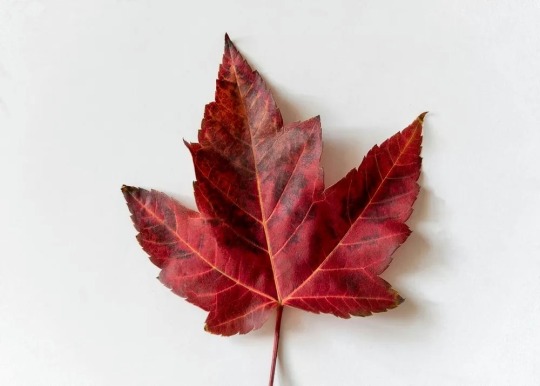
For many, seeing the first maple tree in bloom is a sign that warmer weather is on the way.
Maple trees are native to North America, and there are more than 100 different species. The sugar maple is the most common type of maple tree in the U.S., and its sugar-rich sap is used to make maple syrup.
Maple trees are relatively easy to care for, and they make a great addition to any landscape. If you're thinking of planting a maple tree, here are a few things to keep in mind.
Maple trees prefer full sun and well-drained soil. They are relatively drought-tolerant once they are established, but they will produce more flowers and fruits if they are watered regularly.
Maple trees are available in a variety of sizes, from small shade trees to large specimens. Be sure to choose a tree that is appropriate for the space you have available.
Maple trees can be susceptible to a number of pests and diseases. Be sure to choose a variety that is resistant to the most common problems in your area.
With their bright flowers and glossy leaves, maple trees are a welcome addition to any landscape. With a little care, they will thrive for many years to come.
In fact, maple trees are a keystone species in many North American forests. That means that they play a vital role in the ecosystem, providing food and shelter for a wide variety of animals.
One of the most important animals that rely on maple trees is the sugar maple tree (Acer saccharum). This tree is the primary source of sap for making maple syrup.
But sugar maples are not the only type of maple tree that provides food for animals. Other species of maple trees, such as red maples (Acer rubrum) and silver maples (Acer saccharinum), are also important food sources for a variety of animals.
Here are some of the animals that rely on maple trees for food:
Birds: Many birds, such as woodpeckers, nuthatches, and thrushes, eat the insects that live in maple trees. Maple seeds are also an important food source for some birds, such as finches.
Squirrels: Squirrels eat the buds, twigs, and seeds of maple trees.
Beavers: Beavers eat the bark of maple trees.
Porcupines: Porcupines eat the bark of maple trees.
Deer: Deer eat the leaves of maple trees.
As you can see, maple trees are an important food source for a variety of animals. So next time you see a maple tree, take a moment to appreciate its role in the ecosystem.
0 notes
Text
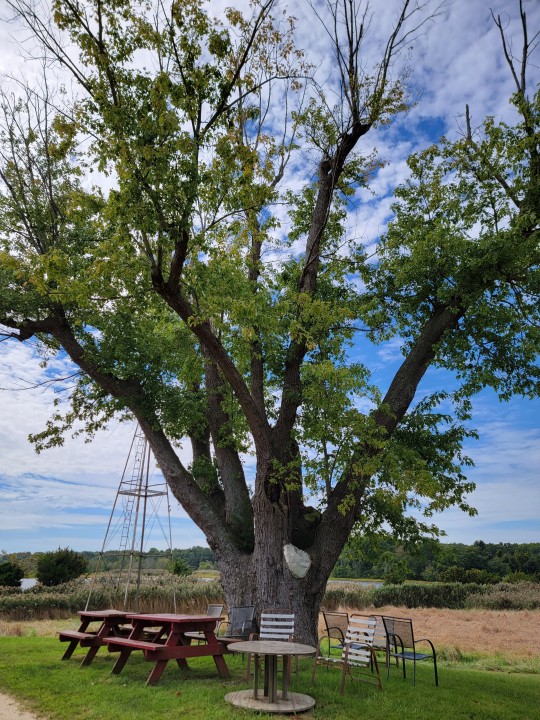
Champion Silver Maple on Diked Farmland - September 17th 2023
#extremely likely this tree is 150-175 years old#the owner started his work here after the civil war he fought for the union#tree photography#champion tree#acer saccharinum
1 note
·
View note
Text
Choosing a 7B Landscape Tree for Your Marietta Yard

Need help selecting the best tree for your Hardiness zone 7b yard? Understanding different tree species’ characteristics and growing habits will help you plant a tree that fits perfectly in your yard.
toddsmariettatreeservices.com gathered the following tree species and growing information for zone 7b landscape trees.
What is a Landscaping Tree?
Landscaping trees are planted to create diversity and serve one of many purposes on your property. These trees come in all shapes and sizes and can be among the most significant assets to your yard by providing shade, privacy screens, wind protection, wildlife refuge, visual interest (curb appeal), and other uses.
What are the Benefits of Landscape Trees?
Landscape trees reduce air pollution and noise pollution. They also filter water and absorb rainfall, lessening the impact of flood and stormwater and preventing soil erosion. Trees also attract a variety of birds and natural wildlife, providing food and shelter.
Note: A large, healthy tree can absorb approximately 40,000 gallons of groundwater annually, returning it to the atmosphere through evapotranspiration.
What are the Best Trees for Your Front Yard?
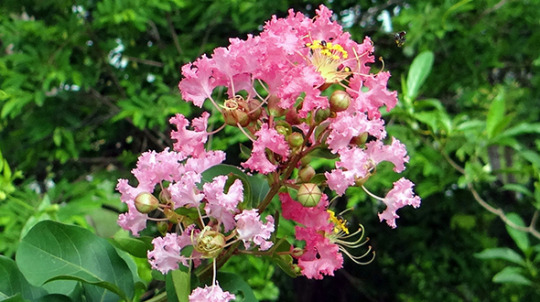
Flowers add pops of color, and mulch creates a clean, well-manicured look. With trees, you can balance height and width in your landscape. Trees are among the best ways to draw the eye, add height, and create a relaxing balance. Curb appeal helps sell a home (trees significantly contribute to curb appeal), and here are a few of the best front yard trees:
Crepe Myrtle (Lagerstroemia) reaches 15 feet
Blue Spruce (Picea pungens) reaches 75 feet
Cherry (Prunus avium) reaches 25 to 30 feet
River Birch (Betula nigra) reaches 60 to 70 feet
Magnolia (Magnolia) reaches 70 to 80 feet
Tip: Avoid catastrophic structural damages by planting your trees at a safe distance from structures on your landscape.
What are the Most Low-Maintenance Landscape Trees?

Once you have determined your tree’s purpose in your landscape (flowers, evergreen shade, privacy, etc.), you should consider the tree’s maintenance. Some landscape plants drop fruit and nuts, while others grow with invasive or surface roots, disturbing your yard, driveway, and foundation. Consider the following low-maintenance landscape trees:
Japanese Maple (Acer palmatum) reaches 25 to 35 feet with delicate branches and vibrant foliage
Jacaranda (Jacaranda) reaches 25 to 40 feet with striking blue and lavender flowers
Redbud (Cercis) reaches 10 to 20 feet with deep red, bright yellow, or two-colored foliage
Frangipani (Plumeria) reaches 20 to 25 feet with non-invasive roots and an abundance of beautiful flowers
Cherry Plum (Prunus cerasifera) reaches 25 feet with deep purple foliage and pink/white flowers
Tip: All tree species require seasonal pruning and thorough inspection after severe weather.
What are the Best Trees to Plant Near a House?

Smaller trees with shallow or non-invasive roots pose little or no risk to your home. Consider the following low-risk tree species:
Weeping Willow (Salix babylonica) reaches 30 to 40 feet
Paper Birch (Betula papyrifera) reaches 50 to 70 feet
Silver Maple (Acer saccharinum) reaches 50 to 80 feet
Sweetgum (Liquidambar) reaches 60 to 75 feet
Crabapple (Malus) reaches 15 to 20 feet
Tip: Towering tree species like southern pines and eucalyptus should be given extra space and not planted within 40 to 50 feet of landscape structures.
Why do Landscape Designers Prefer Male Trees?
Trees with male reproductive organs are preferred in landscapes because they don’t drop messy seed pods or fruit. However, they do produce and release pollen.
Note: When female trees, which capture pollen, are absent from significant landscape areas, the entire area can be blanketed by mass amounts of pollen.
What is the Best Pine Tree to Plant in Zone 7b?
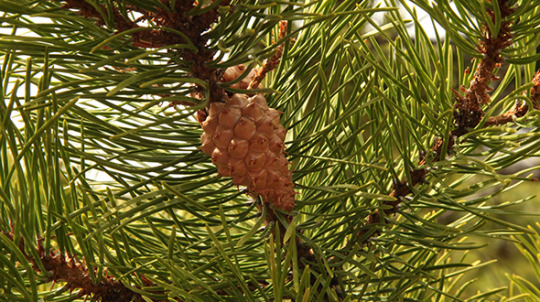
Pine trees are often used in landscapes as privacy screens and specimen trees because they are fast-growing, shapely, and evergreen. Consider the following pine tree species for your landscape needs:
Loblolly Pine (Pinus taeda) reaches 60 to 90 feet
Austrian or Black Pine (Pinus nigra) reaches 50 to 60 feet and requires ample space to flourish
Lodgepole Pine (Pinus contorta) reaches 70 to 80 feet
Red Pine (Pinus resinosa) reaches 50 to 80 feet
Eastern White Pine (Pinus strobus) reaches 50 to 80 feet
Tip: Avoid planting pines near driveways and carports (overhanging branches can leave your vehicle or structure riddled with sap droppings). Pine trees produce and drip sap. The sap flow is heaviest in spring and early summer. During winter, sap slows down and picks up again as spring approaches.
Marietta Georgia Zone 7b Landscape Trees
In this article, you discovered species information and growing characteristics for several popular zone 7b landscape trees.
Knowing which trees to plant around your home and landscape will help you create a beautiful yard with purpose and elevated curb appeal.
Planting the wrong tree species in the wrong location can result in catastrophic root damage to your landscape, driveway, pathway, foundation, and home if it falls on your roof.
Sources:
usgs.gov/special-topics/water-science-school/science/evapotranspiration-and-water-cycle#overview
extension.tennessee.edu/publications/Documents/SP517.pdf
extension.uga.edu/publications/detail.html?number=b625#title11
uaex.uada.edu/publications/pdf/FSA-6126.pdf
Todd’s Marietta Tree Services
Marietta, GA
(678) 505-0266
For the original version of this article visit: https://www.toddsmariettatreeservices.com/choosing-a-7b-landscape-tree-for-your-marietta-yard/
#Landscape Tree#USDA Hardiness Zone 7B#Zone 7B#Marietta Landscape#Tree Service Marietta Ga#Emergency Tree Removal Marietta Ga
1 note
·
View note
Text




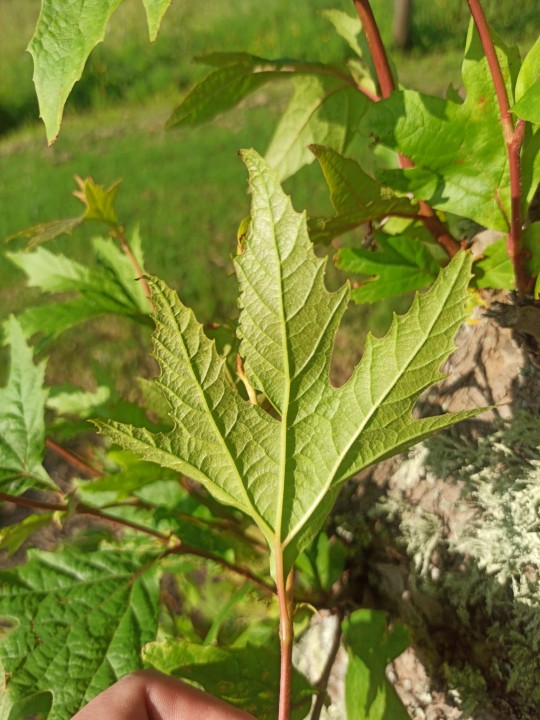


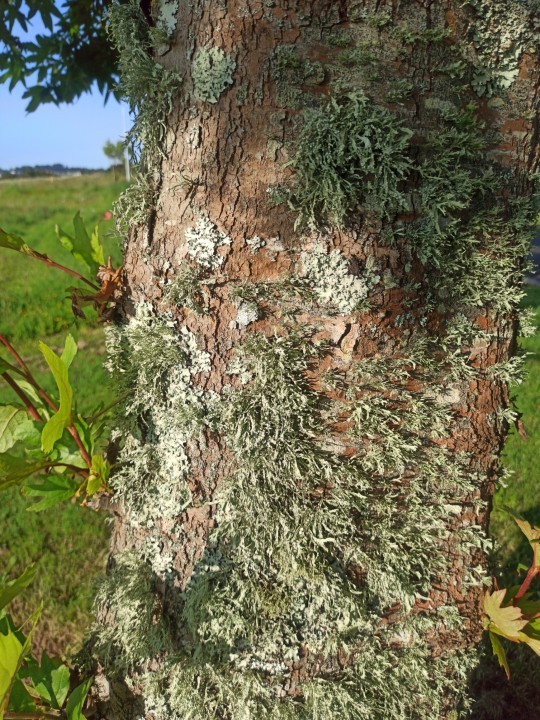

Silver maple, a species of Maples
Also known as:
Soft maple
• Water maple
• River maple
• White maple
• Creek maple
Botanical name: Acer saccharinum
Silver maple ( Acer saccharinum ) is one of the most common deciduous trees in the United States and southeast Canada. It is a 49 to 82 feet tall, fast-growing, sun-loving tree. Its leaves have deeper angular notches between the five lobes than many other maple species. Silver maple is often found along waterways and wetlands, earning it an alternative name “Water maple.”Compared with the typical maple tree, its most unique feature is that its branches and trunks are silver gray, and its tree bark has a silver-white hairy texture. So, it is called silver maple.
Water-maple, River maple
In the United States, it is a common tree and is often spotted in parks or gardens. However, if you happen to go to wetlands or riversides, it's still easy to find. As it is adaptable to wet environments, there is no need to worry about rotting roots caused by water. Also, its capability to adapt to wet environments leads to the naming of the water-maple or river maple.
Interesting Facts
The maple leaf is a symbol of spirit in the hearts of the Canadian people. Those who can catch its leaves will get good luck and blessings. Those who see the falling of its leaves with their beloved ones will get good blessings.
Civic Crescent, Albany, Auckland 0632
7PF6+PJ7 Auckland
-36.7257140, 174.7115420
0 notes
Text
Maple Trees in Maine: 7 Varieties
Maple Trees in Maine: 7 Varieties
Maine is the northeasternmost state in the United States. It is known for having a large abundance of forests, which cover about 90 percent of the land. Naturally, this means it has lots of different trees, including maple trees.
Maple Trees in Maine
The most common species of maple trees in Maine are:
Red Maple (Acer rubrum)
Sugar Maple (Acer saccharum)
Silver Maple (Acer saccharinum)
Striped…

View On WordPress
0 notes
Photo
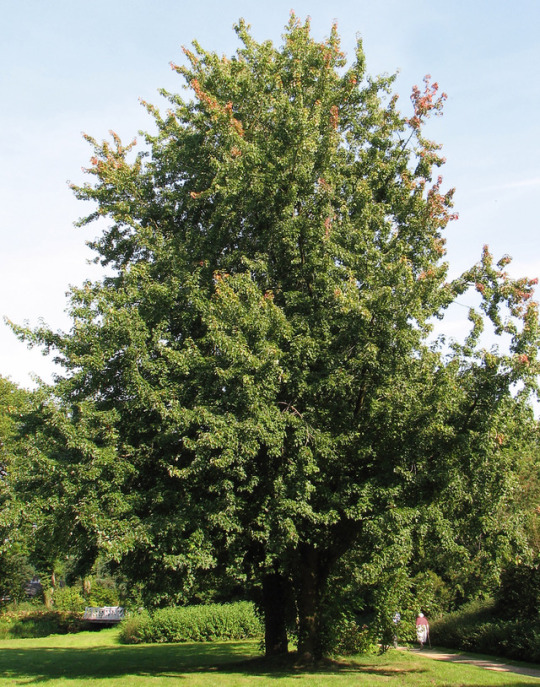
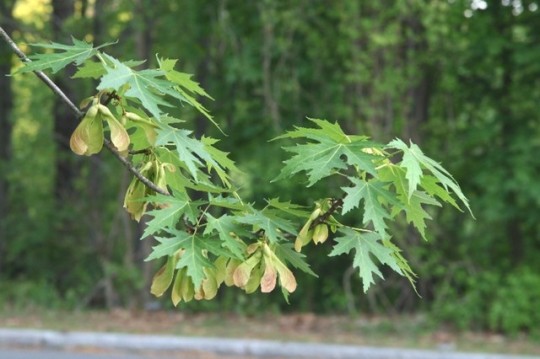
Daily Tree: acer saccharinum
In English please: Silver Maple, Creek Maple, Silverleaf Maple, Soft Maple, Large Maple, Water Maple, Swamp Maple, White Maple
Grows: widespread in the eastern and central continental US
Conservation status: secure
Wikipedia page: here
Photo 1: https : // upload . wikimedia . org/wikipedia/commons/6/64/Silber-Ahorn_%28Acer_saccharinum%29.jpg
Photo 2: https : // gobotany . newenglandwild . org/species/acer/saccharinum/
#Daily Tree#Trees of the US#Trees#acer saccharinum#Silver Maple#Creek Maple#Silverleaf Maple#Soft Maple#Large Maple#Water Maple#Swamp Maple#white maple
22 notes
·
View notes